
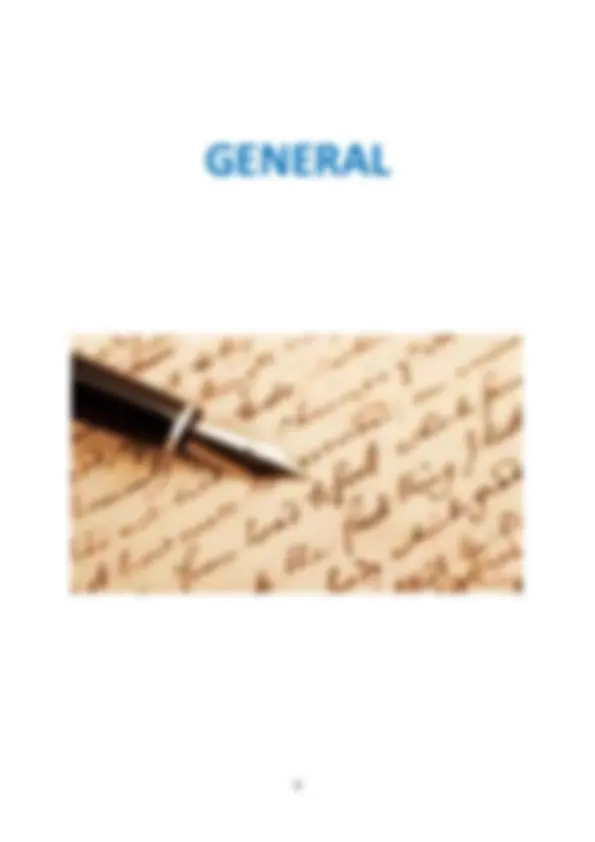
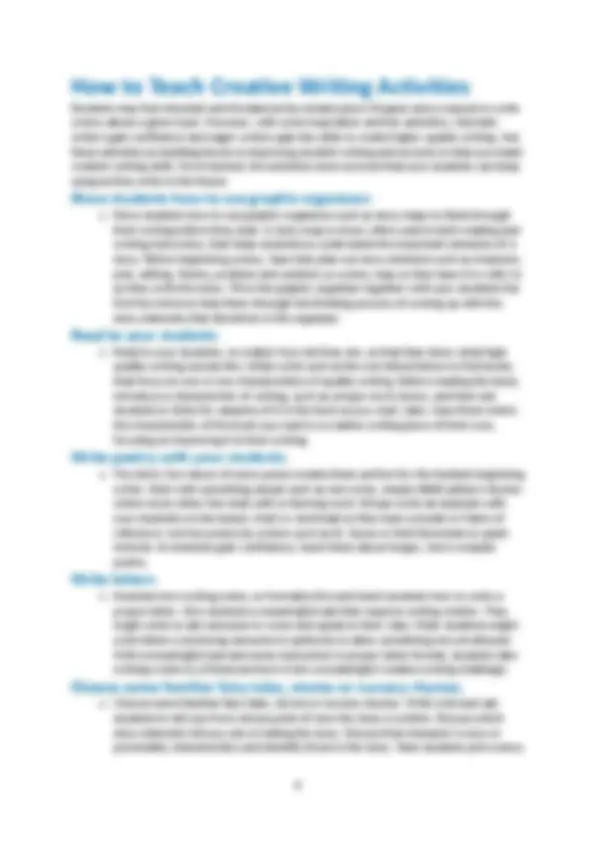
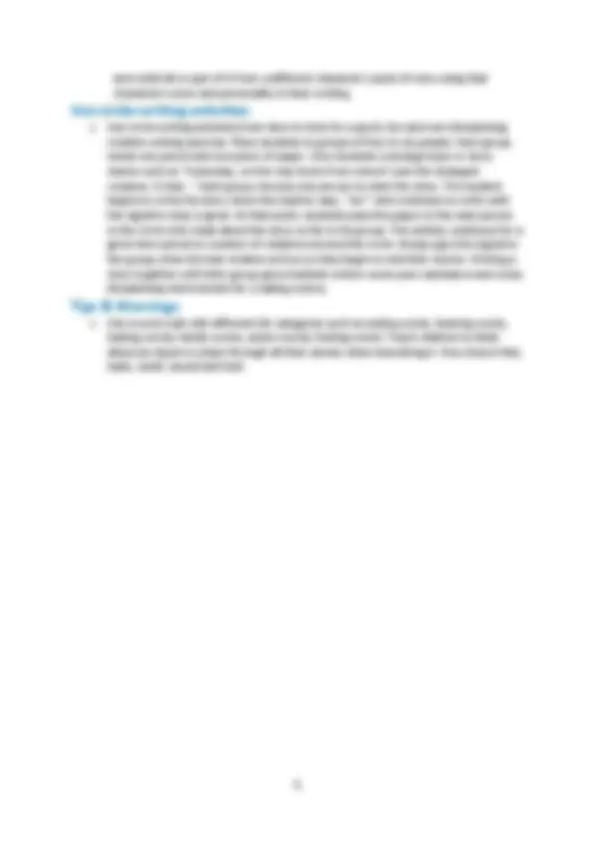

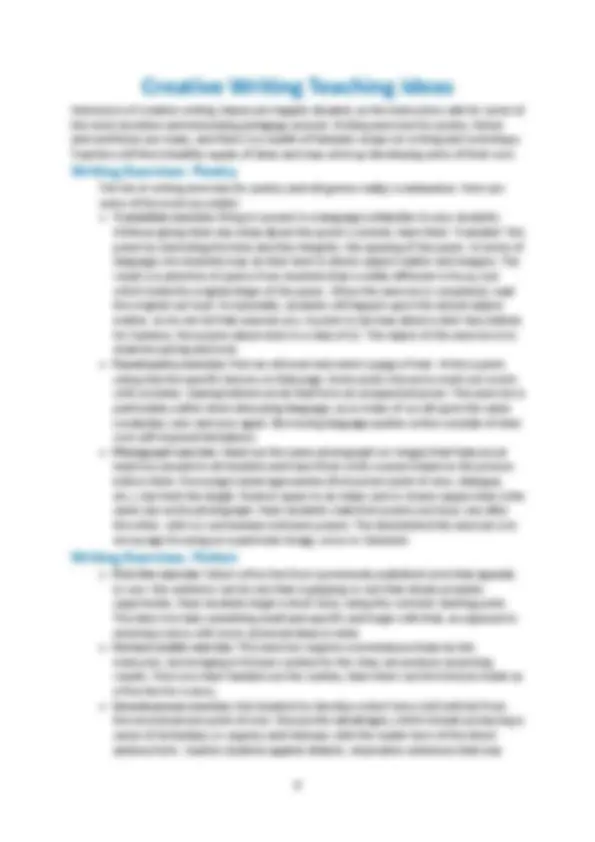
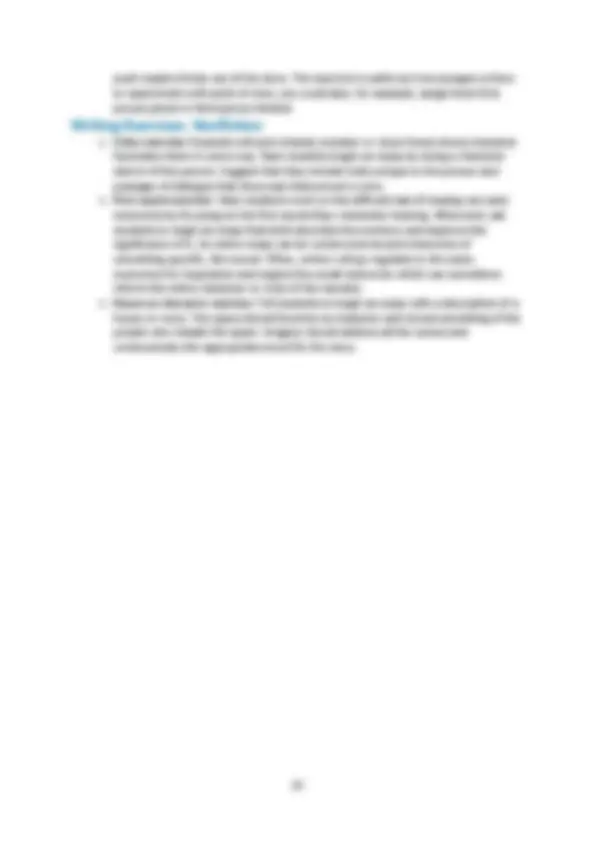


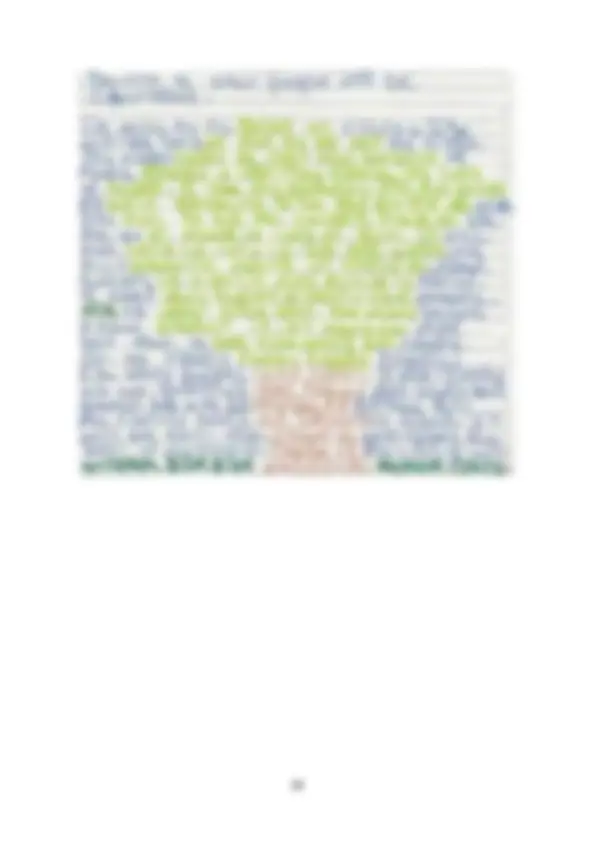
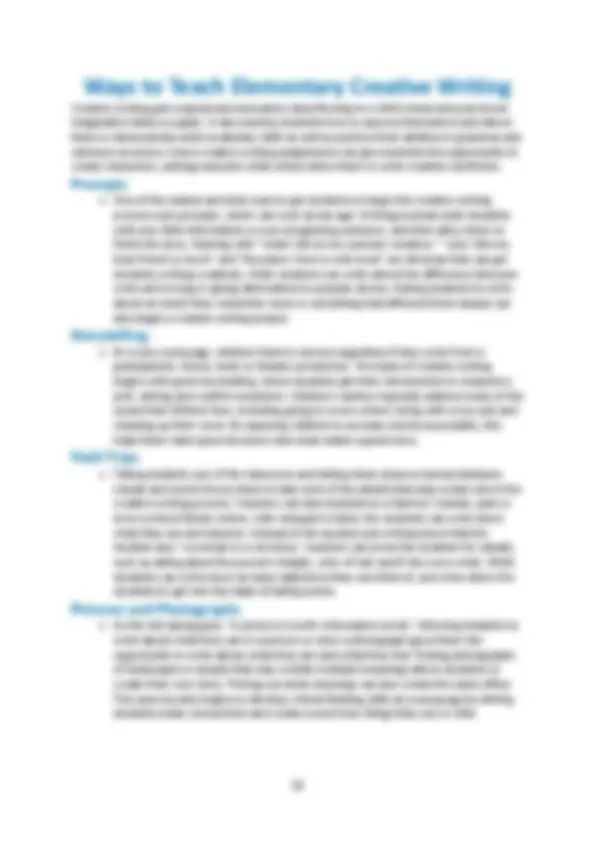
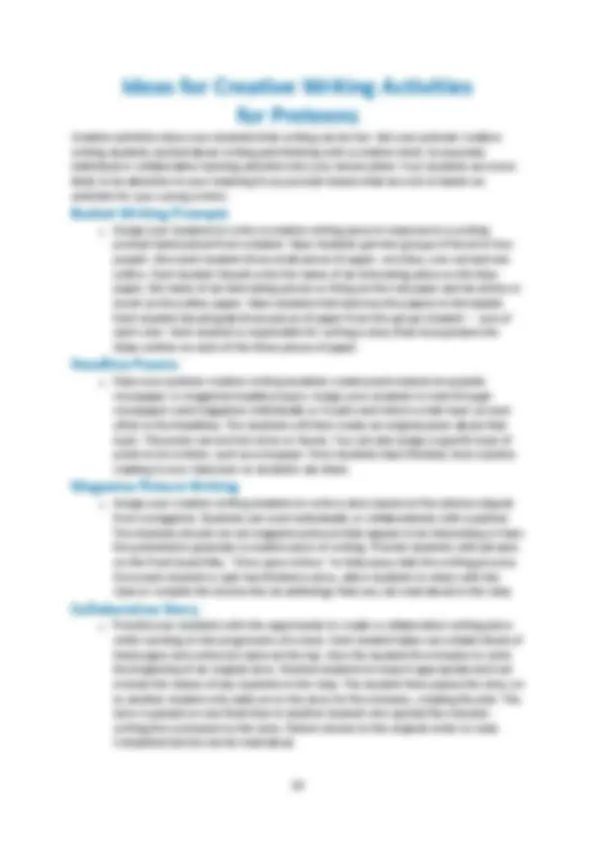

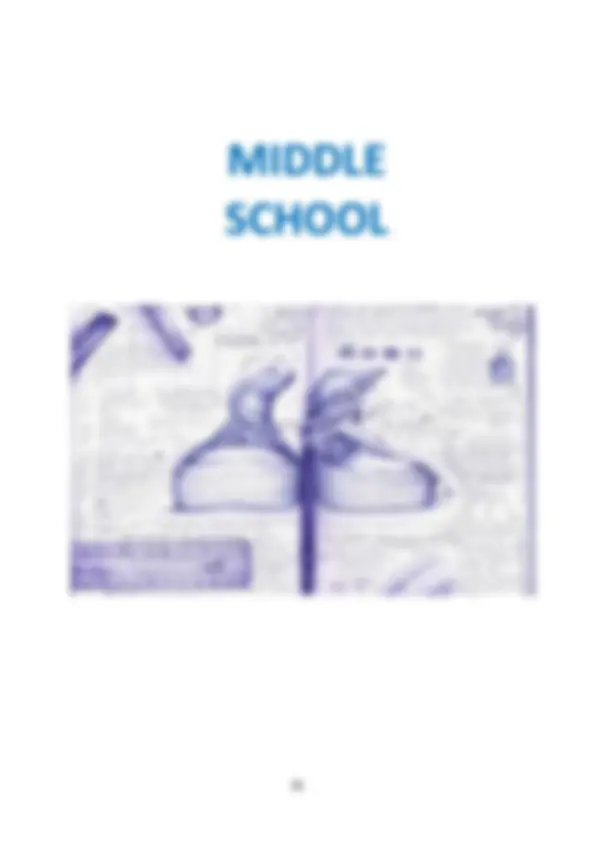
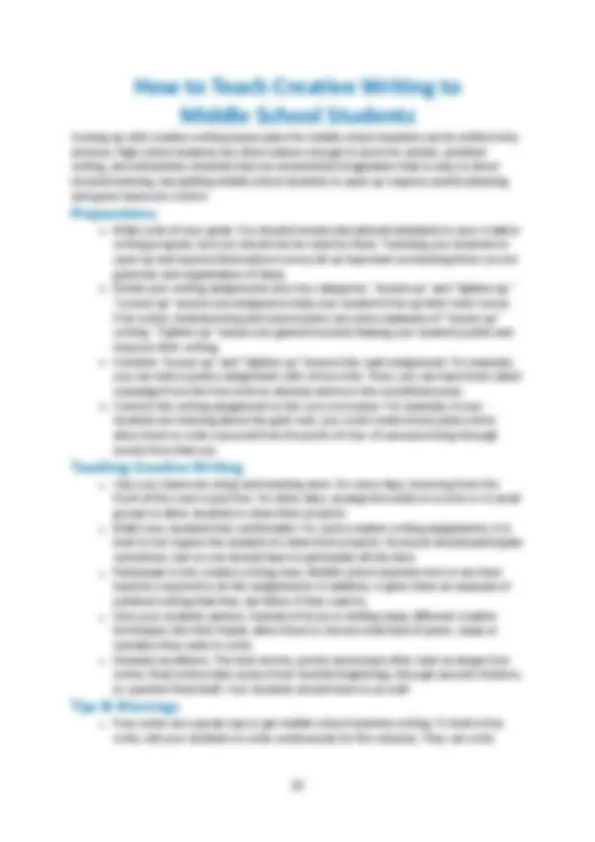

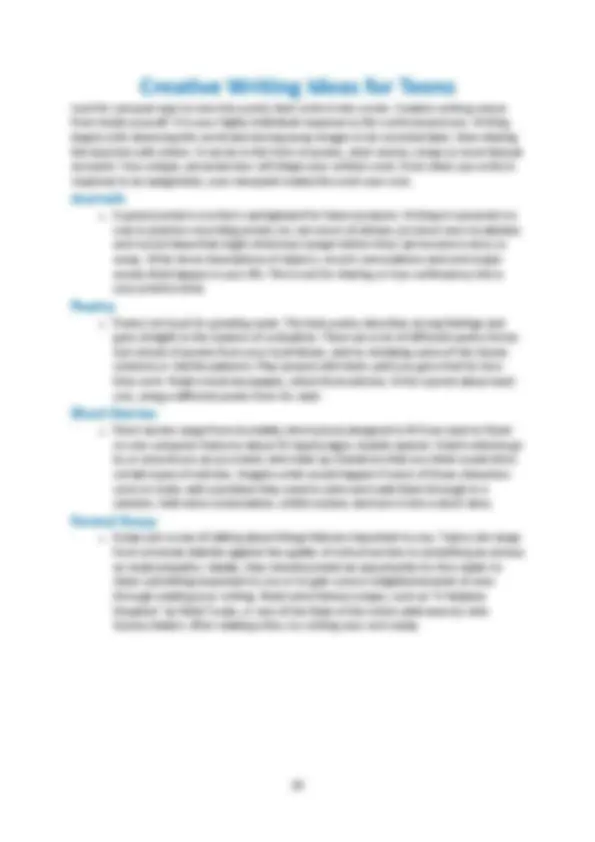
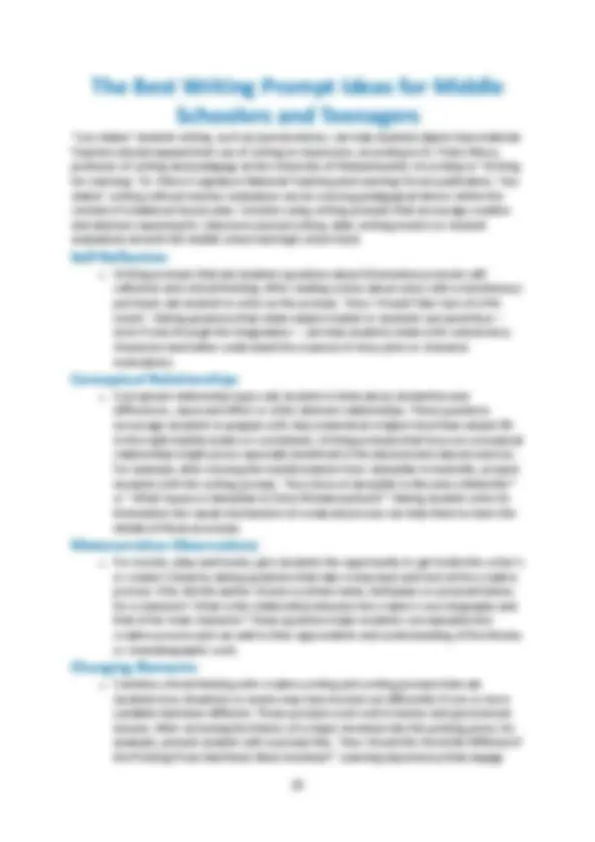

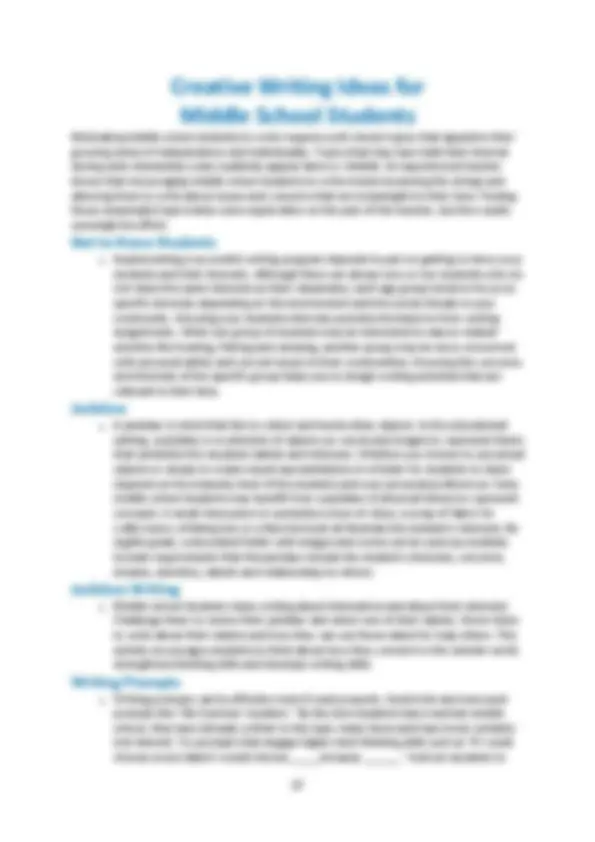


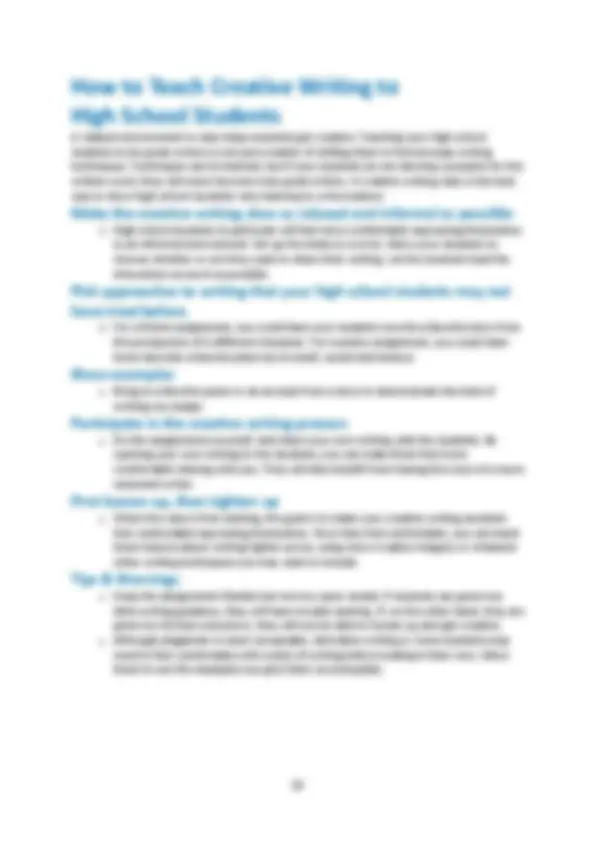
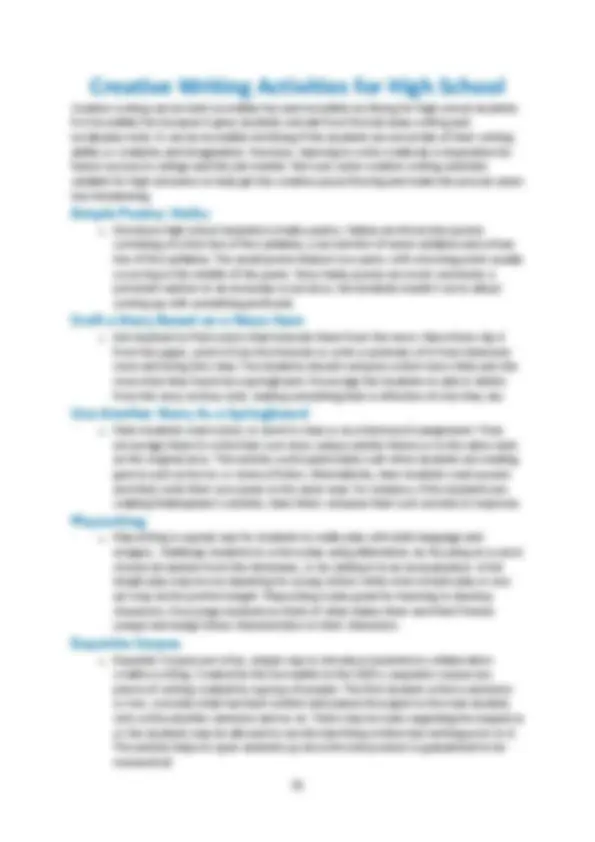

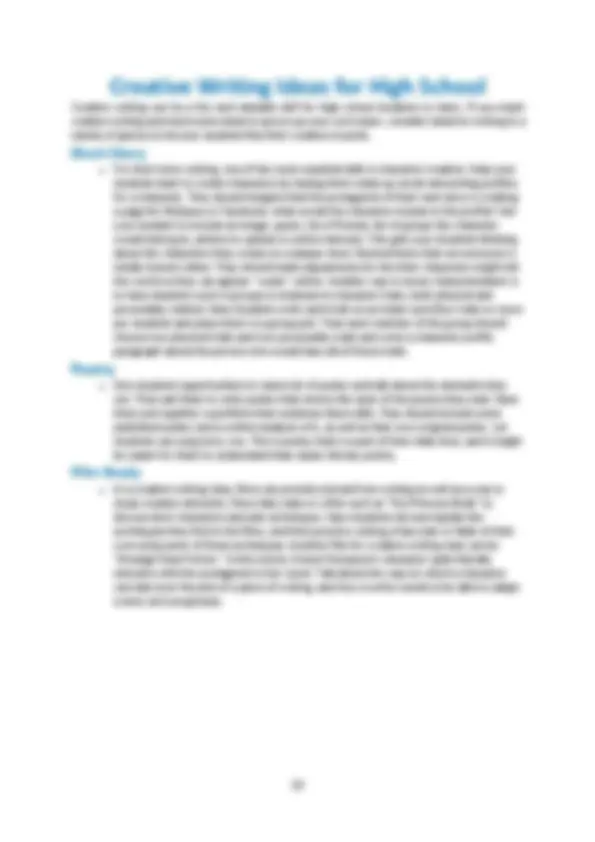
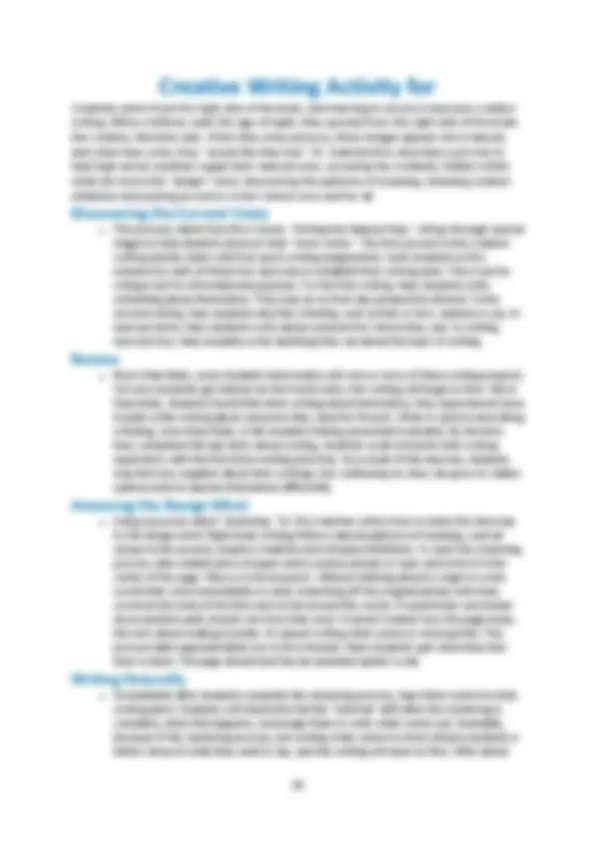



Study with the several resources on Docsity

Earn points by helping other students or get them with a premium plan


Prepare for your exams
Study with the several resources on Docsity

Earn points to download
Earn points by helping other students or get them with a premium plan
Community
Ask the community for help and clear up your study doubts
Discover the best universities in your country according to Docsity users
Free resources
Download our free guides on studying techniques, anxiety management strategies, and thesis advice from Docsity tutors
They might write to ask someone to come and speak to their class. Older students might write letters convincing someone in authority to allow something not yet ...
Typology: Schemes and Mind Maps
1 / 35

This page cannot be seen from the preview
Don't miss anything!




























Source - http: //www.ehow.com
How to Teach Creative Writing Activities
Students may feel reluctant and threatened by a blank piece of paper and a request to write a story about a given topic. However, with some inspiration and fun activities, reluctant writers gain confidence and eager writers gain the skills to create higher quality writing. Use these activities as building blocks to improving student writing and as tools to help you teach creative writing skills. Once learned, the activities serve as tools that your students can keep using as they write in the future.
o Show students how to use graphic organizers such as story maps to think through their writing before they start. A story map is a tool, often used in both reading and writing instruction, that helps students to understand the important elements of a story. Before beginning a story, have kids plan out story elements such as character, plot, setting, theme, problem and solution on a story map so they have it to refer to as they write the story. Fill in the graphic organizer together with your students the first few times to help them through the thinking process of coming up with the story elements that should be in the organizer.
o Read to your students, no matter how old they are, so that they know what high- quality writing sounds like. Utilize a list such as the one linked below to find books that focus on one or two characteristics of quality writing. Before reading the book, introduce a characteristic of writing, such as unique word choice, and then ask students to listen for samples of it in the book as you read. Later, have them mimic the characteristic of the book you read in a creative writing piece of their own, focusing on improving it in their writing.
o The short, fun nature of some poems makes them perfect for the hesitant beginning writer. Start with something simple such as one-verse, simple ABAB pattern rhymes where every other line ends with a rhyming word. Always write an example with your students on the board, chart or overhead so they have a model or frame of reference. Use fun poems by writers such as Dr. Seuss or Shel Silverstein to spark interest. As students gain confidence, teach them about longer, more complex poetry.
o Students love writing notes, so formalize this and teach students how to write a proper letter. Give students a meaningful task that requires writing a letter. They might write to ask someone to come and speak to their class. Older students might write letters convincing someone in authority to allow something not yet allowed. With a meaningful task and some instruction in proper letter format, students take writing a note to a friend and turn it into a meaningful creative writing challenge.
o Choose some familiar fairy tales, stories or nursery rhymes. Write a list and ask students to tell you from whose point of view the story is written. Discuss which story elements tell you who is telling the story. Discuss that character's voice or personality characteristics and identify those in the story. Have students pick a story
and retell all or part of it from a different character's point of view using that character's voice and personality in their writing.
o Use circle-writing activities from time to time for a quick, fun and non-threatening creative writing exercise. Place students in groups of four to six people. Each group needs one pencil and one piece of paper. Give students a strange topic or story starter such as "Yesterday, on the way home from school I saw the strangest creature. It had..." Each group chooses one person to start the story. The student begins to write the story when the teacher says, "Go!" and continues to write until the signal to stop is given. At that point, students pass the paper to the next person in the circle who reads aloud the story so far to his group. The activity continues for a given time period or number of rotations around the circle. Always give the signal to the group when the last rotation arrives so they begin to end their stories. Writing a story together with their group gives hesitant writers some peer assistance and a less threatening environment for creating a story.
o Use a word wall with different list categories such as seeing words, hearing words, tasting words, family words, action words, feeling words. Teach children to think about an object or place through all their senses when describing it. How does it feel, taste, smell, sound and look.
How to Teach Creative Writing to Children
o Ideas, Organization, Voice, Word Choice, Sentence Fluency and Conventions. These six traits provide a way to assess students' writing. When students understand the traits, they know what is expected of their writing. Using and teaching the traits gives you a way to provide specific feedback about each student's skills and needs. Go to http://www.thetraits.org/scoring_guides.php to print out rubrics with detailed feedback for each trait. Use the rubrics to score student's work.
o These prompts could be used for short stories, journaling or oral stories. Vary the types of prompts. You could use famous quotes, paintings, photographs, comic strips, passages from novels, poems, story starters or anything else students might relate to. Visit http://www.creativewritingprompts.com/# to view more than 300 prompts to get students started writing.
o During these evaluations, students read each other's writing and give feedback. Model or script an effective, valuable conference for the class to see. Vary how the partners or groups are organized; choose a friend, teacher's choice, student to the left, etc. Give students a sheet of questions to ask each other and turn in for a grade or credit. Questions could include: What is your favorite part of this story? Is there anything that is confusing to you, if so what? Go to http://oregonstate.edu/~petersp/ORST/WR121_files/course%20resources.htm#gra ding%20and%20peer%20review to learn more about peer evaluation and download examples of student work.
o Students use these to plan out their ideas, characters, plot, main idea and direction of the story before writing. These graphic organizers take brainstorming a step further. They begin to take their ideas and develop them. Go to http://www.educationoasis.com/curriculum/GO/character_story.htm to download graphic organizer templates.
o According to Alice L. Trupe, author of "Revising Practices," "As he [the student] internalizes the feedback, he becomes a better critic of his own writing and progressively incorporates those critical insights into his own drafting and revising processes when writing outside of the classroom."
o Focus the lessons on a small topic like using adjectives to replace the word "good." Teach other mini-lessons about strong verbs, fragments and run-on sentences, figurative language and good leads and conclusions. Go to http://www.jmeacham.com/writers.workshop/writing.mini.lessons.htm to see primary grade mini-lessons.
o Don't limit it to "good" writers, open it up to anyone who wants to join. Let students choose their topics on some assignments. Some students may be discouraged or frustrated if they are always told what to write.
push readers firmly out of the story. The exercise is useful as it encourages writers to experiment with point of view; you could also, for example, assign them first person plural or third person limited.
o Voice exercise: Students will pick a family member or close friend whose character fascinates them in some way. Have students begin an essay by doing a character sketch of this person. Suggest that they include traits unique to the person and passages of dialogue that showcase that person's voice. o First sound exercise : Have students work on the difficult task of teasing out early memories by focusing on the first sound they remember hearing. Afterward, ask students to begin an essay that both describes the memory and explores the significance of it. An entire essay can be constructed around memories of something specific, like sound. Often, writers will go regularly to the same memories for inspiration and neglect the small memories which can sometimes inform the entire character or crisis of the narrator. o House as character exercise: Tell students to begin an essay with a description of a house or room. The space should function as character and reveal something of the people who inhabit the space. Imagery should address all the senses and communicate the appropriate mood for the story.
Ideas for a Creative Writing Course Plan
Creative writing is a way for students to express themselves in new and exciting ways. A creative writing student can gain a greater sense of community and creativity when he writes with his peers, and he can also enhance his introspective skills while writing by himself. Having unique creative writing activities can make the difference between a good class and a great class.
o The focus of a writing cycle is to give students a sense of collaboration with other classmates as they create stories together. Seat the students in a circle and give each student one or two blank notebook pages. Instruct the students to start a story from a prompt of your choice. An example prompt is, "It was noon and the sun was hot..." Allow the students to write from that prompt for two or three minutes, then instruct the class to pass their stories to the person sitting to the left. Repeat the three-minute cycle, passing stories to the left until each story has gone around once. Once students receive their own stories back, ask them to conclude the story with another three-minute time slot of writing.
o This activity takes a special attention to detail and concentration. Instruct each student to write a six-sentence paragraph without repeating any word twice. This includes contractions, such as "do not" and "don't." Tell the students that the paragraphs must make sense and not be a random mixture of ideas. Once the students are finished, gather each paragraph and read it aloud to the class without revealing the names of the authors.
o Spend a week with your students in a journaling unit. Each student should have at least seven pieces of paper available to use for journaling. During each day, starting on the first day of class for the week, instruct the students to fold each piece of paper in half, writing the titles "What I Saw" and "What I Thought about What I Saw." Ask students to journal once or more a day about the things they see throughout the day, and then to reflect upon what they experienced. The purpose of this activity is to form a greater sense of introspection and reflection and to show students the value of keeping a record of daily thoughts.
o This activity is exactly what it sounds like: a marathon. This is a good assignment for classes that seem to be "stuck" or experiencing writer's block. At the beginning of class, instruct students to take out a notebook and pen or pencil. Explain to them that you expect them to keep the writing utensil on the paper for the entire class period. The point is for students to simply write in a continuous stream. Some students may become tired during the activity, but it is important to encourage them to continue writing, even if what they write does not make sense. This stream-of-consciousness style of writing can help break writer's block and help students find new inspiration.
simile or metaphor. Personal narratives are windows into the soul and snapshots into a moment in time that may have passed but lives on forever in memory.
Creative Writing Activities for Primary School
Plant the seed, then watch them grow. If you were to ask any bestselling authors when they started writing, you can bet many would say they found their passion back in primary school. Their inspiration may have come from a certain assignment or an outgoing teacher. Stretching a child's imagination at an early age will help her in the future. All you need are a few writing activities that are creative and fun.
o One advantage of using picture books is they show the link between reading and writing. Choose books that have the words positioned away from the pictures. This makes it easier to cover up the words. Once the words are covered, have the students look through the book and write their own stories, based on what they see. You will be surprised by how many different stories the students will write. Then read the book and have them compare the original story to their versions.
o Not only are journals a way to have students practice writing every day, they are also a way for the students to keep a memento of their school years. You can have the students make their own journals using construction paper and copy paper, or buy premade journals from an office supply store. You can give the students a topic to write about or they can write about what they learned that day.
o An idea box is simply a shoe box covered in paper and stickers. Cut an opening at the top large enough for a child's hand to fit through. Fill the box with different objects. You can use anything from items about your next lesson, to trinkets you find around the house. Let one student pull out an item, and then have the class write a story with that item in it. Have the students add pictures and share their stories.
o Round-robin writing is a way for students to put their heads together to create one story. Give the students a starter sentence, such as "Tommy was late for school," and have the students write for three minutes. Next, have the students rotate their papers in a group. Those students will read the story and continue writing it for three minutes. Do this for three rounds. The students will read their final story to see how it has changed.
How to Teach Creative Writing to
Elementary School Students
Coming up with good creative writing lesson plans for elementary school students can be an absolute joy. Elementary school creative writing classes allow you as the teacher to harness the creativity of young minds and use it to inspire a lifelong passion for learning.
o Make it fun! Take them on a walk to write poems about a particular tree. Have them shout out onomatopoeia words, write them on the blackboard and use them to construct a sound poem as a class. There are probably hundreds of creative writing lesson plans you can start with. The important thing is that you choose one that will show your elementary school students that writing can be a lot of fun. o Bring in examples. Starting is often the most difficult part of the writing process for elementary school students. Allowing them to imitate a particular poem or a passage from a story will get them going. o Consider doing "copy change" assignments. In a copy change, students select a favorite passage from a story and rewrite it, keeping the structure the same while changing the content. For example, they can rewrite a paragraph about how happy a character was so it shows another emotion such as sadness, anger or sleepiness. o Bring in as many senses as possible. For example, have them describe a favorite place using sight, sound, touch, taste and smell. Alternately, you could turn off the lights and have each of them come up with an observation about the classroom that doesn't involve sight.
o Allow each student to choose a favorite assignment to polish and perfect. This will give your elementary writers a sense of ownership over their compositions. o Use group feedback. Have each student say two things they like about each piece of writing and one that could be improved. o Use partner editing to catch spelling and grammar mistakes. This will help your students learn how to catch their own errors through learning to spot the mistakes made by other students. o Compile all of the finished pieces into a class writing book. Give each student a copy. Make them feel proud about what they have accomplished, both individually and as a class.
Ideas for Creative Writing Activities
for Preteens
Creative activities show your students that writing can be fun. Get your preteen creative writing students excited about writing and thinking with a creative mind. Incorporate individual or collaborative learning activities into your lesson plans. Your students are more likely to be attentive to your teaching if you provide lessons that are rich in hands-on activities for your young writers.
o Assign your students to write a creative writing piece in response to a writing prompt hand-picked from a basket. Have students get into groups of three to four people. Give each student three small pieces of paper: one blue, one red and one yellow. Each student should write the name of an interesting place on the blue paper, the name of an interesting person or thing on the red paper and an action or event on the yellow paper. Have students fold and toss the papers in the basket. Each student should grab three pieces of paper from the group's basket --- one of each color. Each student is responsible for writing a story that incorporates the ideas written on each of the three pieces of paper.
o Have your preteen creative writing students create poems based on popular newspaper or magazine headline topics. Assign your students to look through newspapers and magazines individually or in pairs and select a main topic as seen often in the headlines. The students will then create an original poem about that topic. The poem can be free-verse or rhyme. You can also assign a specific type of poem to be written, such as a cinquain. Once students have finished, host a poetry reading in your classroom so students can share.
o Assign your creative writing students to write a story based on five photos clipped from a magazine. Students can work individually or collaboratively with a partner. The students should cut out magazine pictures that appear to be interesting or have the potential to generate a creative piece of writing. Provide students with phrases on the front board like, "Once upon a time," to help jump start the writing process. Once each student or pair has finished a story, allow students to share with the class or compile the stories into an anthology that you can read aloud to the class.
o Provide your students with the opportunity to create a collaborative writing piece while working on the progression of a story. Each student takes out a blank sheet of lined paper and writes his name at the top. Give the student five minutes to write the beginning of an original story. Remind students to keep it appropriate and not include the names of any students in the class. The student then passes the story on to another student who adds on to the story for five minutes, creating the plot. The story is passed on one final time to another student who spends five minutes writing the conclusion to the story. Return stories to the original writer to read. Completed stories can be read aloud.
How to Create Creative Writing Lessons
for Elementary
Encourage your students to write what's on their mind each day. Creating writing exercises stimulate students' imagination and enhance their ability to express themselves in words. In the early years of a child's education, creative writing exercises must be enjoyable for students so they're engaged in the lesson. The exercises also have to teach students about creative storytelling and the fundamental components that make up a story.
o Each week, give students daily or weekly journal prompts and encourage them to think creatively about their answers. Some possible questions include, "What would you do if you woke up and saw a dinosaur in your backyard," or "If you could sit down to lunch with a someone famous, who would it be and why?" Creative journal writing prompts that encourage students to invent stories or describe family members and pets are also effective.
o Ask students to pick three numbers between one and 10. Each number corresponds to a specific character, setting and situation that you've selected. Students match their chosen numbers to find out what elements they need to use in their stories. For example, a student may need to write about an alien at a shopping mall late at night or a new mom at a city park during a concert.
o Turn a creative writing exercise into a history lesson by having students write about a historical figure. It can either be a historical figure you've assigned to them or a person of their choosing. Students write from the perspective of the historical figure and examine questions such as the accomplishments they are most proud of, their most regrettable moment and their favorite childhood memory.
o In the beginning of the school year, students can create and personalize their own journals with a stack of white-lined paper tucked between two pieces of card stock or construction paper. Have these journals professionally bound or simply staple them in place, depending on your classroom resources.